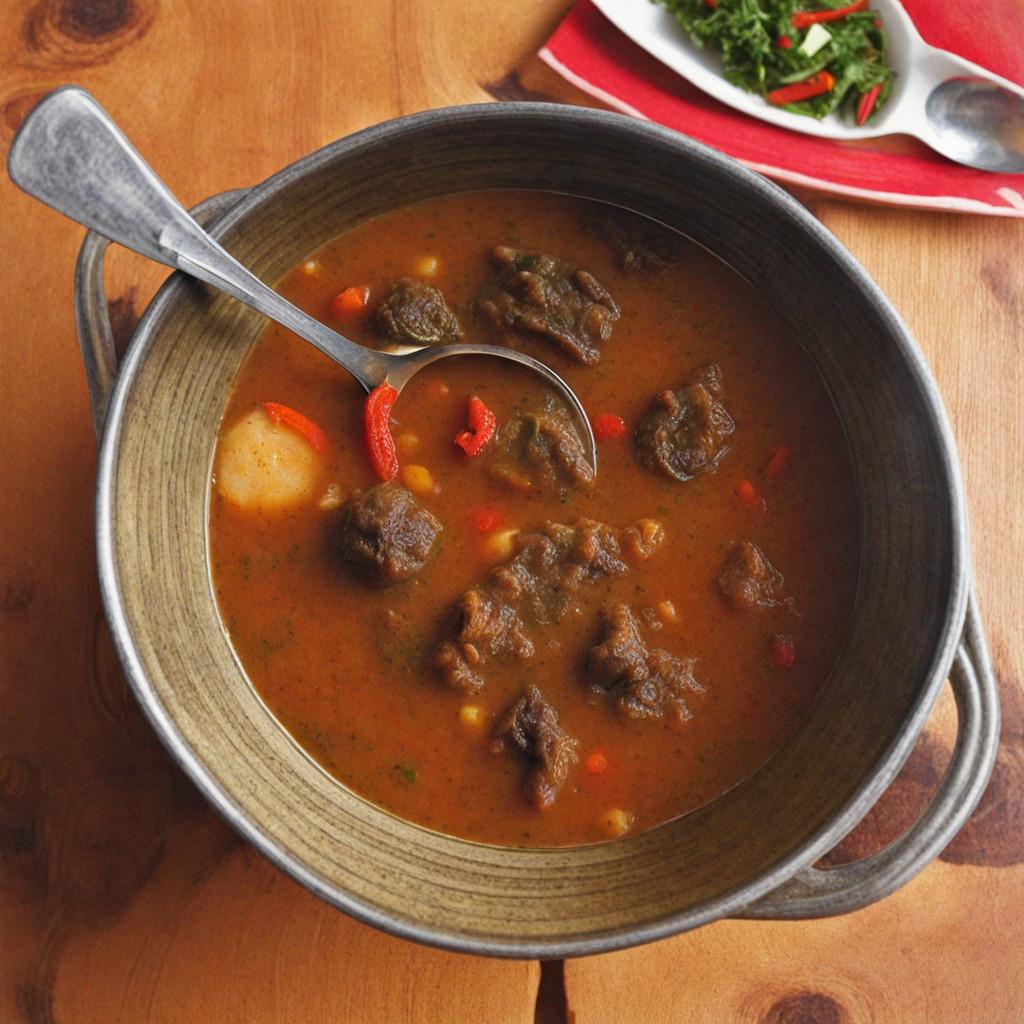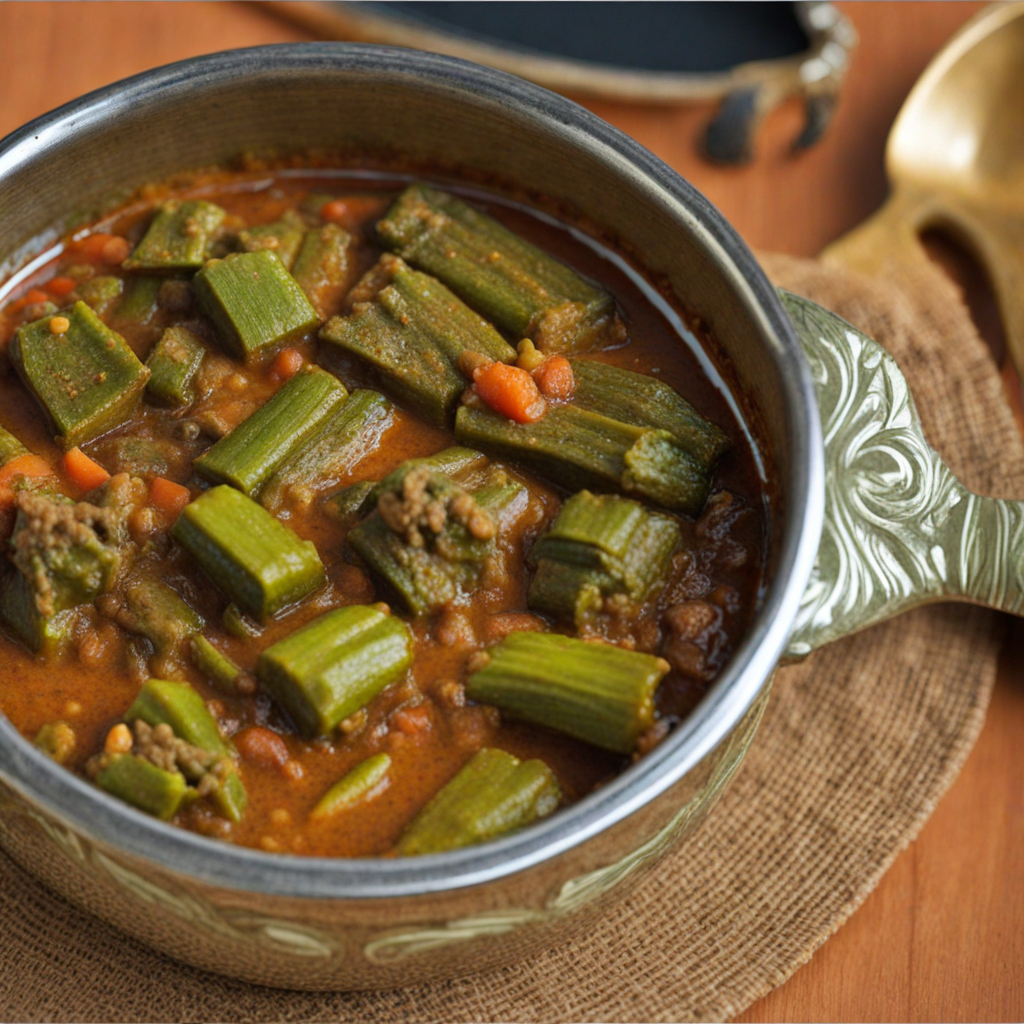Pepper Soup
Pepper soup is a vibrant and aromatic dish that hails from Sierra Leone, celebrated for its bold flavors and warming qualities. This traditional soup typically features a rich broth infused with an array of spices, including pepper, ginger, and garlic, creating a tantalizing fusion that awakens the senses. The heat from the peppers is balanced by the earthiness of the spices, making each spoonful a delightful experience. Often prepared with fresh fish or meat, the soup showcases the natural flavors of its ingredients, allowing them to shine through the savory broth. In Sierra Leone, pepper soup is not just a meal; it is a cultural experience often enjoyed during communal gatherings or special occasions. The soup is usually served steaming hot, inviting diners to savor its warmth and depth. Accompanied by a side of rice or yam, it becomes a hearty dish that nourishes both body and soul. The use of local ingredients, such as wild spices and fresh herbs, adds an authentic touch, making every bowl a reflection of the region's culinary heritage. One of the unique aspects of Sierra Leonean pepper soup is its versatility. Chefs can customize the soup with various protein options, including chicken, goat, or even snail, catering to different palates and preferences. The addition of vegetables such as okra or leafy greens contributes a delightful texture and nutritional value, enhancing the overall experience. For those seeking an adventurous culinary journey, pepper soup serves as a perfect introduction to the rich and diverse flavors of Sierra Leonean cuisine, leaving a lasting impression that beckons for a second helping.
How It Became This Dish
The History of Pepper Soup in Sierra Leone Origin and Early Beginnings Pepper soup is a beloved dish in Sierra Leone, renowned for its rich flavors and comforting warmth. Its history is deeply rooted in the culinary traditions of West Africa, where the use of spices and herbs is integral to the region’s gastronomy. The dish is thought to have originated from the indigenous practices of cooking with local ingredients, which were shaped by the diverse cultural influences that have swept across the region over centuries. Historically, Sierra Leone has been a melting pot of cultures, primarily due to its position as a trading hub for enslaved people and goods. The arrival of the Temne, Mende, and other ethnic groups brought a variety of cooking techniques and flavors, laying the groundwork for a rich culinary landscape. The use of pepper, particularly the African bird’s eye chili, is a testament to this heritage. This small but potent chili is not just a spice; it symbolizes the vibrancy of Sierra Leonean cuisine. Cultural Significance In Sierra Leone, pepper soup transcends mere sustenance; it is a dish steeped in cultural significance. Traditionally, it is believed to have medicinal properties, often served to those recovering from illness or as a remedy for common ailments. The combination of hot peppers, ginger, and other spices is thought to stimulate the senses and improve circulation, making it a favored dish during the cooler rainy season. Pepper soup also plays a pivotal role in social gatherings and celebrations. It is commonly prepared for communal events, including weddings, funerals, and festivals. Sharing a steaming bowl of pepper soup fosters community bonds, echoing the culture of hospitality that is prevalent in Sierra Leone. The act of cooking and sharing this dish reflects the values of kinship and togetherness that are central to Sierra Leonean society. Development Over Time As Sierra Leone's history evolved, so too did its culinary practices. The influences of colonialism, migration, and globalization have all contributed to the development of pepper soup. During the British colonial period, new ingredients and cooking techniques were introduced, but the essence of local cuisine remained intact. The adaptation of pepper soup to incorporate new ingredients while retaining its core flavors exemplifies the resilience and adaptability of Sierra Leonean food culture. In contemporary Sierra Leone, pepper soup has seen a resurgence, particularly in urban areas where a younger generation is reclaiming traditional dishes. Chefs and home cooks alike are experimenting with variations of the recipe, incorporating seafood, chicken, or even goat meat, to cater to diverse palates. This evolution reflects a broader trend in which traditional dishes are reinterpreted, allowing for innovation while honoring the past. Modern media has played a significant role in popularizing pepper soup beyond Sierra Leone’s borders. Social media platforms and cooking shows have introduced international audiences to the dish, showcasing its vibrant colors and aromatic appeal. As a result, pepper soup is beginning to gain recognition in global culinary circles, celebrated for its bold flavors and health benefits. The Ingredients and Preparation At its core, pepper soup is a simple dish, yet it is the careful selection of ingredients that elevates it to a culinary delight. The primary components include meat (often fish, chicken, or goat), a variety of spices, and aromatic vegetables such as onions and garlic. The real star of the dish, however, is the pepper, which brings heat and complexity. The preparation typically begins with marinating the meat in a blend of spices and herbs, allowing the flavors to meld. The meat is then simmered in water, with the addition of a spice mix that often includes ingredients like lemongrass, ginger, and the aforementioned African bird’s eye chili. The resulting broth is fragrant and deeply flavorful, with a vibrant kick that warms the palate. Traditionally, pepper soup is served hot, often accompanied by rice or yam, which helps to balance the heat. In many households, it is common to enjoy pepper soup as a communal dish, with everyone gathered around a pot, ladling generous portions into bowls. This communal aspect of the meal reinforces the cultural significance of sharing food and fostering connections among family and friends. Modern Interpretations and Global Reach In recent years, the globalization of food culture has led to increased interest in African cuisines, and pepper soup is no exception. Restaurants specializing in Sierra Leonean and West African dishes are emerging in cities around the world, introducing diners to the bold and spicy flavors that characterize the region's culinary heritage. Chefs are now incorporating pepper soup into fusion cuisine, blending traditional recipes with contemporary techniques and ingredients. The dish's versatility has also made it a canvas for creativity. Some chefs experiment with different proteins, incorporating shrimp or crab for a coastal twist, while others play with the spice levels to cater to varying preferences. These modern interpretations not only celebrate the dish's heritage but also highlight its adaptability in an ever-changing culinary landscape. Conclusion: A Dish of Resilience and Unity Pepper soup is more than just a meal; it is a reflection of Sierra Leone’s rich history and cultural identity. From its humble beginnings as a local remedy to its status as a cherished communal dish, pepper soup embodies the resilience and adaptability of Sierra Leonean cuisine. In a world increasingly influenced by globalization, the dish stands as a testament to the importance of culinary traditions in fostering community and preserving cultural heritage. As pepper soup continues to evolve, it remains a symbol of the warmth and hospitality that defines Sierra Leone. Each bowl serves as a reminder of the past while inviting new generations to explore and embrace their culinary roots. In every spicy sip, one can taste the stories of resilience, unity, and the enduring power of food to bring people together.
You may like
Discover local flavors from Sierra Leone







